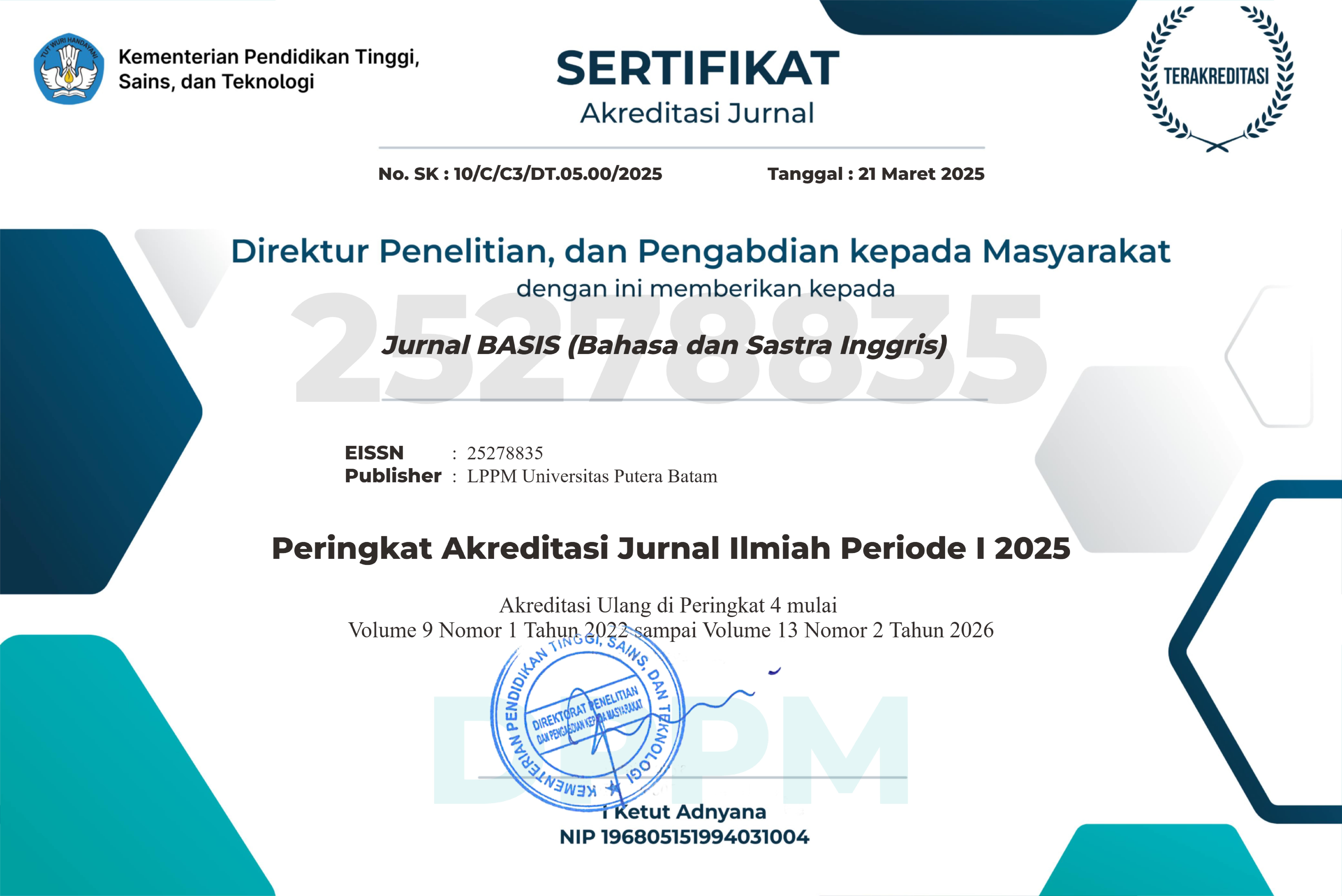PARADOXICAL REPRESENTATION OF FEMALE NARATION IN THE SPIRIT OF MAK UNGKAI STORY
DOI:
https://doi.org/10.33884/basisupb.v6i2.1413Kata Kunci:
The Sea Ghost Tale, Ecofeminism, ParadoxicalAbstrak
The story of Mak Ungkai sea ghost is very commonly heard by old generation of Malay people in Batam coast. The sea ghost portrayed as a scary female ghost, disturbing humans, sinking fishing boats, and harassing coastal people. On the other hand, researchers suspected a paradoxical narrative of Mak Ungkai character which is relatively close to nature, preserves the environment, and counter-patriarch. This problem directed to examine more deeply the image of women in this phenomenon to reveal the interpretation behind the story. This research used an ecofeminist approach with the aim of reversing the stereotypes of women narrated by the community against the character of Mak Ungkai and its relation to the environment and nature. According to Shiva (1998), ecocritic is a new cosmology that views nature and women as having relationships that maintain, cooperate and protect one another. By using descriptive qualitative method, researchers collected data in depth interviews and immediately plunged into the community. Interviews were conducted directly with 5 speakers from the indigenous Malay community in Sebulang Island, Batam. The research used recordings and cameras which are then transcribed in narrative texts that are easily understood. The results of the study found that (1) the existence of patriarchal stereotypes through mak ungkai sea ghost story (2) the paradoxical representation of women based on ecofeminist framework behind the story.
Referensi
Arianto, T., & Ambalegin. (2019). Indoctrination Against Women in “The Lowland” by Jhumpa Lahiri. OKARA: Jurnal Bahasa Dan Sastra, 12(2), 153–166. https://doi.org/http://dx.doi.org/10.19105/ojbs.v12i2.1935.
Atmazaki. (2007). Ilmu Sastra: Teori dan Terapan. Padang: Citra Budaya.
Bressler, C. E. (2007). Literary Criticism: An Introduction to Theory and Practice 4th-ed. Pearson Education. London: Pearson Education, Inc.
Dagun, S. M. (1992). Maskulin dan Feminin: Pria dan wanita dalam fisiologi, psikologi, seksual, karir, dan masa depan. Jakarta: Rineka Cipta.
Danandjaja, J. (1984). Folklor Indonesia : Ilmu Gosip, Dongeng, dan lain-lain. Jakarta: Grafiti Pers.
Fakih, M. (2003). Analisis Gender dan Transformasi Sosial. Yogyakarta: Pustaka Pelajar.
Faruk. (2012). Metode Penelitian Sastra, Sebuah Penjelajahan Awal. Yogyakarta: Pustaka Pelajar.
Gasouka, M. (2017). The Importance of Feminist Ethnography in Modern Folklore Studies. International Journal of Scientific and Research Publications, 7(12), 541–544. Retrieved from http://www.ijsrp.org/research-paper-1217/ijsrp-p7272.pdf
Hutomo, S. S. (1991). Mutiara yang Terlupakan: Pengantar Studi Sastra Lisan. Surabaya: HISKI Komisariat Jawa Timur.
Rahadini, A. A., & Rahmat. (2018). Philosophical meaning of the myth of pregnant and nursing mothers at Dawuhan village, Banyumas. EduLite Journal of English Education, 3(2), 190–195. https://doi.org/http://dx.doi.org/10.30659/e.3.2.188-195
Sakina, A., & Dessy. (2017). Menyoroti budaya patriarki di Indonesia. Share Social Work Journal, 7(1), 71–79. https://doi.org/10.24198/share.v7i1.13820
Shiva, V. (1998). Bebas dari pembangunan: perempuan, ekologi dan perjuangan hidup di India. Terj. Hira Jhamtani. Jakarta: Yayasan Obor Indonesia.
Stanton, R. (2007). Teori Fiksi Robert Stanton. Diterjemahkan oleh Sugihartuti dan Rossi Abi Al Irsyad. Yogyakarta: Pustaka Pelajar.
Sugihastuti. (2010). Kritik Sastra Feminisme, teori, dan aplikasinya. Yogyakarta: Pustaka Pelajar.
Taum, Y. Y. (2011). Studi Sastra Lisan: Sejarah, Teori, Metode, dan Pendekatan Disertai Contoh Penerapannya. Yogyakarta: Lamalera.
Teeuw, A. (2010). Sastra dan Ilmu Sastra: Pengantar Teori Sastra. Jakarta: Dunia Pusat Jaya.
Tong, R. (2009). Feminist Though: Third Edition (3rd ed.). Colorado: Westview Press.
Wiyatmi, Suryaman, M., & Swatikasari, E. (2017). Ekofeminisme: Kritik Sastra Berwawasan Ekologis dan feminis. Yogyakarta: Cantrik Pustaka.
##submission.downloads##
Diterbitkan
Terbitan
Bagian
Lisensi













 JURNAL BASIS (BAHASA DAN SASTRA INGGRIS)
JURNAL BASIS (BAHASA DAN SASTRA INGGRIS)
